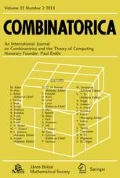Abstract
In “The structure of hereditary properties and colourings of random graphs” [Combinatorica 20(2) (2000), 173–202], Bollobás and the second author studied the probability of a hereditary property P in the probability space G(n,p). They found simple properties that closely approximate P in this space, and using these simple properties they determined the P-chromatic number of random graphs.
In this note we point out that the analysis of hereditary properties in G(n,p) can be made more exact by means of the extremal properties of 2-coloured multigraphs, and we illustrate some cases in which the probability of P can thereby be calculated. At the same time we correct a mistake in the cited paper.
Similar content being viewed by others
References
V. E. Alekseev: On the entropy values of hereditary classes of graphs, Discrete Math. Appl. 3 (1993), 191–199.
N. Alon and U. Stav: What is the furthest graph from a hereditary property?, Random Structures and Algorithms 33 (2008), 87–104.
M. Axenovich, A. Kézdy and R. Martin: On the editing distance of graphs, J. Graph Theory 58 (2008), 123–138.
J. Balogh and R. Martin: Edit distance and its computation, Electronic Journal of Combinatorics 15 (2008), #R20.
B. Bollobás and A. Thomason: Projections of bodies and hereditary properties of hypergraphs, J. London Math. Soc. 27 (1995), 417–424.
B. Bollobás and A. Thomason: Hereditary and monotone properties of graphs, in: The Mathematics of Paul Erdős II (R. L. Graham and J. Nešetřil, eds.), Algorithms and Combinatorics 14, Springer-Verlag, (1997), 70–78.
B. Bollobás and A. Thomason: The structure of hereditary properties and colourings of random graphs, Combinatorica 20(2) (2000), 173–202.
W. G. Brown, P. Erdős and M. Simonovits: Extremal problems for directed graphs, J. Combinatorial Theory (Ser. B) 15 (1973), 77–93.
W. G. Brown, P. Erdős and M. Simonovits: Inverse extremal digraph problems, in: Finite and Infinite Sets, Eger (Hungary), 1981, Colloq. Math. Soc. János Bolyai 37, Akad. Kiadó, Budapest (1985), 119–156.
W. G. Brown, P. Erdős and M. Simonovits: Algorithmic solution of extremal digraph problems, Trans. Amer. Math. Soc. 292 (1985), 421–449.
E. Marchant and A. Thomason: Extremal graphs and multigraphs with two weighted colours, in: Fete of Combinatorics and Computer Science, Bolyai Soc. Math. Stud. 20, (2010), 239–286.
H. J. Prömel and A. Steger: The asymptotic structure of H-free graphs, in: Graph Structure Theory (N. Robertson and P. Seymour, eds), Contemporary Mathematics 147, Amer. Math. Soc., Providence, 1993, pp. 167–178.
D. C. Richer: Ph.D. thesis, University of Cambridge (2000).
U. Stav: personal communication.
Author information
Authors and Affiliations
Corresponding author
Additional information
Research funded by Trinity College, University of Cambridge.
Rights and permissions
About this article
Cite this article
Marchant, E., Thomason, A. The structure of hereditary properties and 2-coloured multigraphs. Combinatorica 31, 85–93 (2011). https://doi.org/10.1007/s00493-011-2630-7
Received:
Published:
Issue Date:
DOI: https://doi.org/10.1007/s00493-011-2630-7




